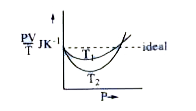(A): At constant volume on increasing temperature the collision frequency increases.
(R) : Collision frequency is directly proportional to temperature of the gasSolution in Telugu
Both (A) and ( R) are true and (R ) is the correct explanation of (A)
Both (A) and (R ) are true and (R ) is not the correct explanation of (A)
(A) is true but (R ) is false
Both (A) and (R ) are false
The correct Answer is:C
Step by step video, text & image solution for (A): At constant volume on increasing temperature the collision frequency increases. (R) : Collision frequency is directly proportional to temperature of the gas by Physics experts to help you in doubts & scoring excellent marks in Class 11 exams.
Updated on:21/07/2023Topper's Solved these Questions
- KINETIC THEORY OF GASESBook:AAKASH SERIESChapter:KINETIC THEORY OF GASESExercise:EXERCISE-2(Kinetic Theory of an ideal gas)
Explore 25 Videos
- KINETIC THEORY OF GASESBook:AAKASH SERIESChapter:KINETIC THEORY OF GASESExercise:EXERCISE-3(Kinetic Theory of an ideal gas)
Explore 4 Videos
- KINETIC THEORY OF GASESBook:AAKASH SERIESChapter:KINETIC THEORY OF GASESExercise:EXERCISE-IA(Degree of Freedom)
Explore 35 Videos
- KINEMATICSBook:AAKASH SERIESChapter:KINEMATICSExercise:ADDITIONAL PRACTICE EXERCISE (PRACTICE SHEET (ADVANCED)) (Integer Type Questions)
Explore 12 Videos
- LAWS OF MOTIONBook:AAKASH SERIESChapter:LAWS OF MOTIONExercise:PRACTICE EXERCISE
Explore 108 Videos
Similar Questions
cylinder of capacity 20 litres is filled with H2 gas. The total average kinetic energy of translatory motion of its molecules is 1.5×105 J. The pressure of hydrogen in the cylinder is
View SolutionGiven is the graph between PV/T and P for 1 gm of oxygen gas at two different temperature T1 and T2 (Given:Density of oxygen=1.429kg/m3).The value of PV/T at the point A and the relation between T1 and T2 and respectively

View SolutionA cylinder rolls without slipping down an inclined plane, the number of degrees of freedom it has, is
View SolutionThree particles start from origin at the same time: one with velocity v1 along positive x - axis, the second along the positive y-axis with a velocity v2 and the third along the line y=x with such a speed that all the three always stay in a straight line, then the velocity of the third particle is √kV1V2(V1+V2).
View SolutionA force of 50 N acts on a body of mass 10 kg at rest. Its velocity after 5 seconds if the same force acts, is
View SolutionAssertion: The pressure of a fixed amount of an ideal gas is proportional to its temperature.
Reason: Frequency of collisions and their impact both increase in proportion of the square root of temperature.
View SolutionAssertion: The pressure of a fixed amount of an ideal gas is proportional to its temperature.
Reason: The Frequency of collisions and their impact both increase in proportion of the square root of temperature.
View SolutionStatement: The rate of a chemical reaction increases as the temperature is increased.
Explanation: The collision frequency between the reactant molecules increases on increasing the temperature.
View SolutionAs the temperature of a metal conductors increase the frequency of collision of electrons …….. and time of relation of the electrons……
View SolutionAssertion: Rate of constant increases with the increase in temperature.
Reason: Number of collisions increase with the increase in temperatures.
View SolutionStatement-1. The pressure of a fixed amount of an ideal gas is proportional to its temperature. Statement-2. Frequency of collisions and their impact both increase in proportion to the square root of the temperature.
View SolutionThe pressure of a fixed amount of an ideal gas is proportional to its temperature . Frequency of collision and their impact both increase in proportion to the square root of temperature . True/ false.
View SolutionA : At constant volume on increasing temperature the collision frequency increases. R : Collision frequency prop temperature of gas.
View SolutionA : Arrhenius parameter
(A) = P (steric factor) × z (collision frequency)
R : On increasing temperature , the value of A increases.
View SolutionAssertion: The pressure of a fixed amount of an ideal gas is proportional to its temperature.
Reason: The Frequency of collisions and their impact both increase in proportion of the square root of temperature.
View Solution

